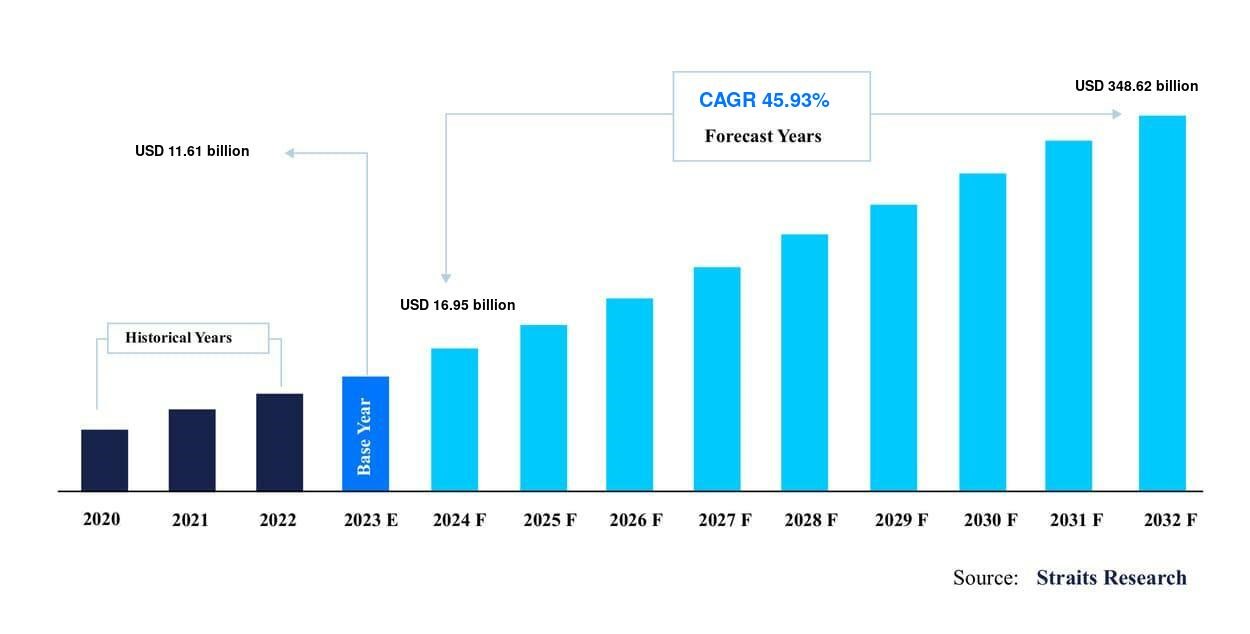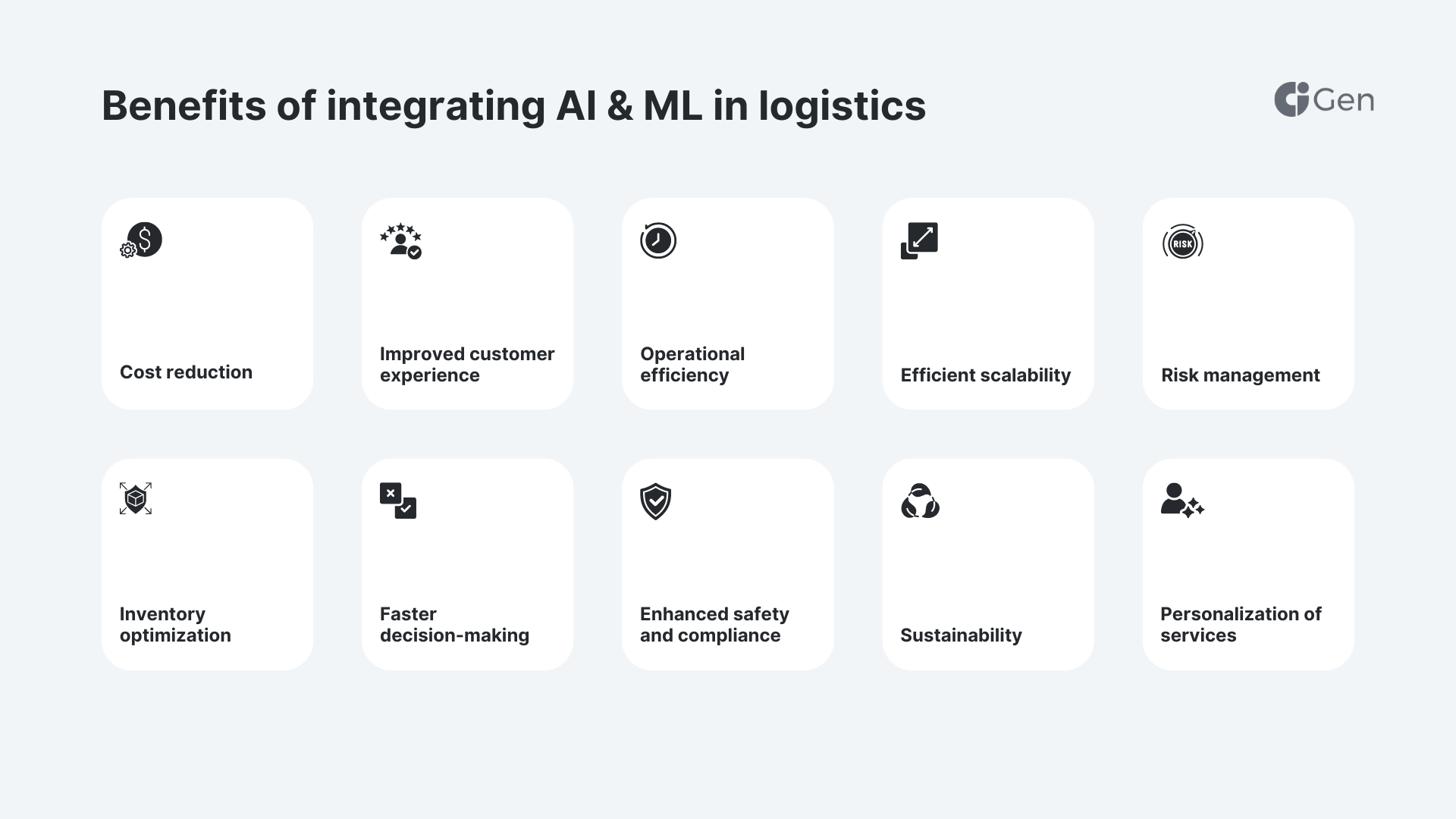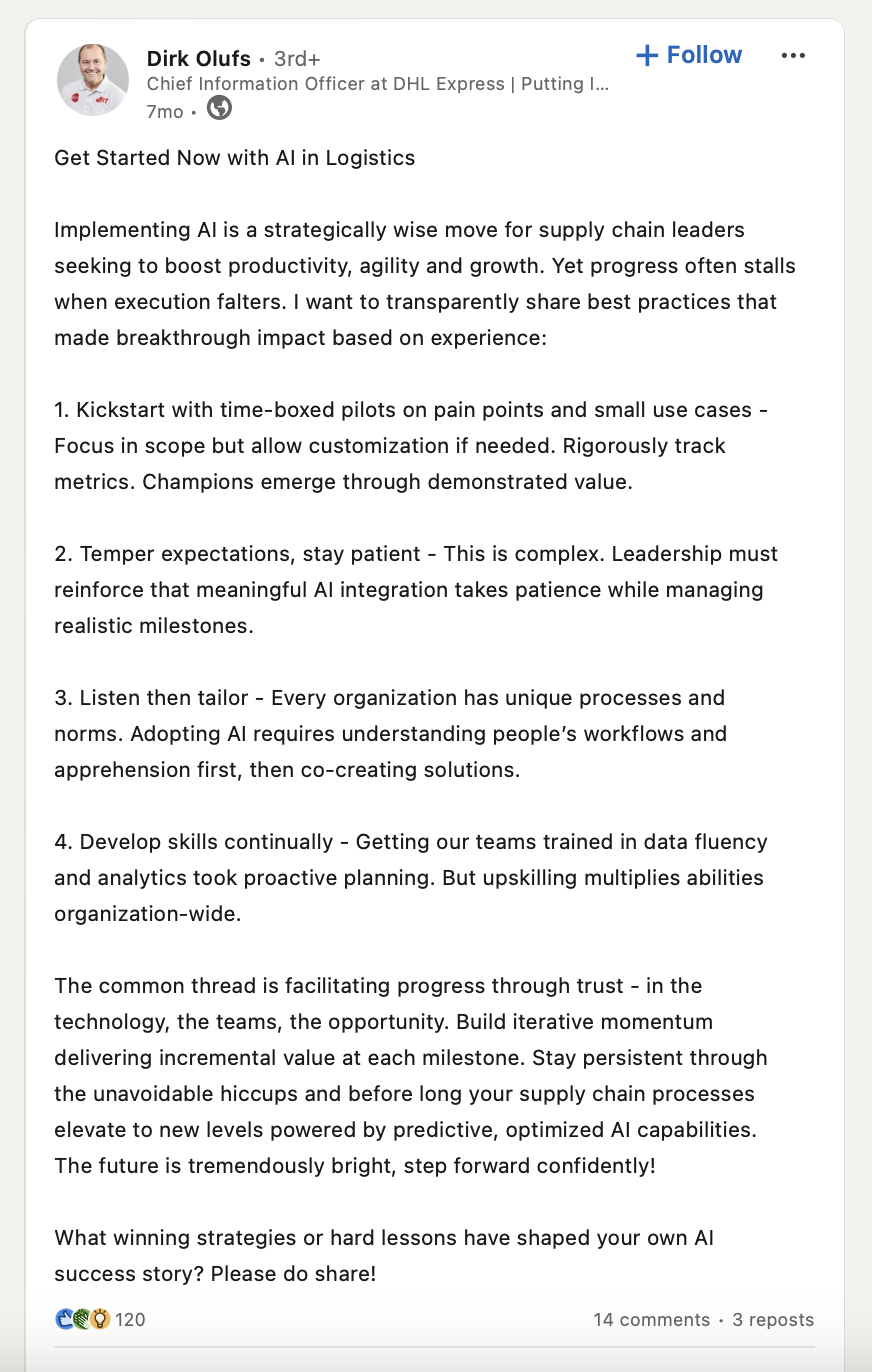Artificial Intelligence is transforming the logistics industry, reshaping how supply chains operate and enabling businesses to scale their operations efficiently.
According to a recent report by Straits Research, the global AI in logistics market was valued at USD 11.61 billion in 2023 and is projected to reach USD 16.95 billion in 2024, growing exponentially to USD 348.62 billion by 2032 at a staggering CAGR of 45.93%.

This surge is primarily driven by the expansion of e-commerce, which has increased the demand for faster, more reliable logistics services. AI technologies are being leveraged to optimize every facet of logistics, from predicting demand and managing inventory to streamlining supply chain operations and ensuring timely deliveries.
As AI continues to evolve, its ability to automate routine tasks, reduce costs, and enhance customer experience makes it an essential tool for modern logistics companies looking to stay competitive in a fast-paced, data-driven world.
To better understand the technology and its potential impact on the T&L industry let’s deep-dive into its major categories, benefits, and concerns.
Benefits of integrating AI and ML in logistics
Artificial Intelligence (AI) and Machine Learning (ML) are transforming the logistics industry by enabling smarter, faster, and more efficient operations. AI and ML provide a competitive edge by streamlining processes, improving decision-making, and delivering cost savings.
The following key benefits illustrate why AI and ML integration is becoming essential for logistics operations:
Cost reduction
AI helps optimize fuel usage, reduce idle time, and minimize manual intervention, directly cutting operational costs.
Operational efficiency
AI-powered predictive analytics enable dynamic route planning and fleet management, reducing delays and improving on-time deliveries.
Improved customer experience
AI-driven chatbots and real-time shipment tracking provide greater transparency, enhancing customer satisfaction and loyalty.
Scalability
AI allows logistics operations to scale efficiently, adapting to fluctuations in demand without the need for proportionate increases in manual labor or physical assets.
Risk management
AI can predict potential disruptions, such as extreme weather or geopolitical events, allowing companies to adjust their logistics strategies proactively.
Inventory optimization
AI-driven forecasting helps in maintaining optimal inventory levels by predicting demand spikes or shortages, reducing the costs associated with overstocking or stockouts.
Faster decision-making
AI processes data in real time, enabling logistics companies to make faster and more informed decisions, from route changes to delivery scheduling.
Enhanced safety and compliance
AI-based monitoring tools can ensure that vehicles are operating within legal and safety guidelines, automatically flagging any compliance risks.
Sustainability
By optimizing routes and load capacities, AI can contribute to reducing fuel consumption and emissions, helping logistics companies meet sustainability goals.
Personalization of services
AI analyzes customer preferences and behaviors to offer personalized shipping solutions, improving customer retention and competitive advantage.

Key concerns and challenges when adopting AI in logistics operations
While AI and machine learning (ML) offer numerous benefits, adopting these technologies in logistics comes with several challenges. Successfully implementing AI requires careful planning, investment, and a focus on mitigating potential risks. Logistics companies must navigate a variety of concerns to ensure a smooth transition to AI-powered operations.
The following key challenges highlight what logistics software development companies need to address when adopting AI technologies:
Data privacy & security
AI relies heavily on large volumes of data, much of which is sensitive. Ensuring data privacy and security is a top priority, as any breaches could lead to significant reputational and financial damage. Companies must build robust cybersecurity protocols to safeguard their data.
Talent shortage
A shortage of AI and data science professionals can delay or complicate the implementation of AI solutions. Companies may need to invest in upskilling their workforce or partner with external vendors specializing in AI.
High initial costs
The integration of AI systems requires significant upfront investments in infrastructure, software, and training. Demonstrating early ROI through pilot projects and incremental improvements can help justify these costs to stakeholders.
Integration with legacy systems
Many logistics companies operate on legacy systems that are incompatible with modern AI tools. Ensuring seamless integration requires careful planning, often involving custom-built solutions and phased implementations.
Data quality and availability
AI algorithms thrive on high-quality data. Inconsistent, incomplete, or outdated data can hinder the effectiveness of AI models. Ensuring a solid data strategy is essential for success.
Cultural resistance
The transition to AI-driven processes can face resistance from employees accustomed to traditional methods. Overcoming this challenge requires strong leadership, clear communication, and ongoing training programs to ease the shift toward AI-based operations.
Regulatory compliance
AI adoption must comply with industry regulations and legal requirements, especially in areas like data handling, privacy laws, and safety standards. Non-compliance could result in legal repercussions and fines.
Ethical concerns
AI raises ethical questions related to decision-making, fairness, and transparency. Companies must address these concerns by ensuring that their AI systems operate in a transparent and accountable manner.
Major AI technologies used in the logistics and transportation industry
Artificial Intelligence (AI) is revolutionizing logistics, supply chain management, and transportation by providing advanced solutions that streamline operations, improve decision-making, and enhance overall efficiency. The integration of AI involves several key technologies, each with its own role and value proposition. Let’s explore these technologies and their subsets in detail.
Machine Learning (ML)
Machine learning is at the core of AI applications in logistics. ML algorithms enable systems to learn from data, identify patterns, and make decisions with minimal human intervention. In logistics, ML is widely used for:
- Predictive analytics: ML models analyze historical and real-time data to forecast demand, inventory requirements, and transportation needs. By predicting these variables, logistics companies can optimize their operations, reduce costs, and avoid disruptions.
- Demand forecasting: Based on historical data and market trends, ML algorithms predict future demand for products, allowing companies to adjust their inventory levels and minimize stockouts or overstocking.
- Predictive maintenance: ML models analyze equipment and vehicle performance data to predict when maintenance is needed, preventing breakdowns and reducing downtime.
- Anomaly detection: ML algorithms are used to detect anomalies in operations, such as fraudulent activities, unusual shipping patterns, or delays. This helps in identifying risks early and mitigating them.
Deep Learning (DL)
Deep learning is a subset of machine learning that uses artificial neural networks to model complex relationships in data. It excels at tasks like image recognition, natural language understanding, and decision-making, which are vital for automating processes in logistics.
- Image recognition for warehouse automation: Deep learning is used to automate visual tasks such as identifying items, counting inventory, and scanning barcodes, which enhances warehouse management.
- Autonomous vehicles: Deep learning is critical in developing self-driving trucks, drones, and other autonomous vehicles. It allows these vehicles to navigate safely and efficiently by processing sensor data and making real-time decisions.
- Robotic Process Automation (RPA): DL algorithms in combination with RPA help in automating repetitive tasks such as sorting parcels, managing stock, and updating shipment records.
Natural Language Processing (NLP)
NLP allows AI systems to understand, interpret, and respond to human language, making it useful for a variety of applications in logistics and supply chain management.
- AI chatbots and Virtual Assistants: NLP-powered chatbots provide 24/7 customer support by answering queries related to order status, shipment tracking, and delivery details. Virtual assistants also help employees manage and track inventory using voice commands.
- Automated documentation: NLP enables automatic generation, analysis, and translation of shipping documents, invoices, and reports. This reduces paperwork and speeds up customs processing.
- Sentiment analysis: NLP algorithms are used to gauge customer sentiment from reviews and feedback. This helps logistics companies tailor their services and address customer concerns more effectively.
Computer vision
Computer vision is an AI technology that enables machines to interpret and understand visual data from the physical world. In logistics, it has various applications:
- Automated sorting and packing: Computer vision systems, often coupled with robotic arms, are used to identify and sort packages based on size, shape, and barcode data, reducing manual labor and increasing speed.
- Vehicle inspections: AI-powered cameras can perform automatic inspections of trucks and vehicles, identifying wear and tear or damage before it leads to larger problems.
- Surveillance and security: In warehouses and distribution centers, computer vision is used to monitor security footage, detecting unauthorized access or unusual activities, improving facility safety.
Reinforcement Learning (RL)
Reinforcement learning is a subset of machine learning where an agent learns to make decisions by interacting with an environment and receiving feedback (rewards or penalties). In logistics, RL is used for:
- Dynamic route optimization: RL helps optimize routing for delivery fleets by learning the best routes based on real-time traffic data, fuel consumption, and delivery times.
- Autonomous systems: RL algorithms are vital for autonomous forklifts, drones, and trucks that need to make real-time decisions in complex environments. These systems improve efficiency and reduce human labor costs.
- Inventory management: RL models can help optimize inventory placement in warehouses by continuously learning the most efficient layout based on historical order data and current trends.
Robotic Process Automation (RPA)
RPA involves using AI to automate repetitive tasks typically performed by humans. RPA systems in logistics are transforming operations by:
- Order processing: RPA automates tasks such as order entry, shipment scheduling, and invoicing, reducing human error and speeding up operations.
- Inventory updates: RPA continuously updates inventory levels as shipments arrive and leave, ensuring real-time accuracy across multiple locations.
- Supplier communications: RPA can automate routine supplier interactions, such as sending purchase orders or confirming delivery schedules, saving time for procurement teams.
Internet of Things (IoT) and AI integration
The integration of AI with IoT technologies enables real-time monitoring and management of logistics operations by connecting physical assets to digital systems.
- Real-time asset tracking: IoT devices equipped with sensors are used to track shipments, vehicles, and containers in real-time. AI algorithms process this data to optimize routes, predict delivery times, and prevent delays.
- Condition monitoring: IoT sensors monitor environmental factors such as temperature, humidity, and vibration for sensitive goods (e.g., pharmaceuticals or perishables), while AI systems analyze this data to ensure proper handling and alert managers of any potential issues.
- Fleet management: AI analyzes data from IoT devices on vehicles to optimize fleet performance, including fuel efficiency, driver behavior, and route planning.
Digital twins
A digital twin is a virtual representation of a physical object, system, or process. In logistics, AI-powered digital twins are becoming increasingly popular for simulating and optimizing operations.
- Supply chain simulation: AI-powered digital twins can model the entire supply chain, allowing companies to simulate various scenarios, such as demand fluctuations, supplier delays, or route changes, and predict the outcomes before making decisions.
- Warehouse management: Digital twins of warehouses allow logistics companies to simulate different layouts, employee workflows, and inventory placements to maximize efficiency and reduce operational costs.
- Transportation networks: Digital twins of transportation networks help companies understand the impact of real-time factors like traffic and weather on delivery schedules, enabling them to make proactive adjustments.
Cognitive computing
Cognitive computing systems attempt to simulate human thought processes using AI, machine learning, and data mining. In logistics, these systems enhance decision-making and problem-solving:
- Supply chain planning: Cognitive computing systems analyze vast amounts of structured and unstructured data to help logistics companies forecast demand, assess risks, and create more efficient supply chain strategies.
- Personalized delivery services: Cognitive computing can analyze customer preferences and delivery history to offer personalized shipping options, including preferred delivery times or methods.
Edge AI
Edge AI refers to the deployment of AI algorithms at the edge of the network, close to the devices generating the data (e.g., sensors, cameras, or IoT devices). This is crucial in logistics for real-time decision-making:
- Real-time data processing: By processing data locally at the edge, logistics companies can reduce latency and make quicker decisions, such as rerouting vehicles based on real-time traffic or weather conditions.
- Warehouse robotics: Edge AI enables robots and autonomous vehicles in warehouses to operate without relying on cloud-based systems, making real-time decisions on tasks such as sorting and inventory movement.
Autonomous vehicles and drones
AI is also at the forefront of the development and deployment of autonomous vehicles and drones, which are transforming last-mile delivery:
- Self-driving trucks: AI systems in self-driving trucks use deep learning, computer vision, and sensor data to navigate safely and efficiently without human intervention. This is set to reduce transportation costs significantly.
- Delivery drones: AI-powered drones are being used for last-mile delivery, particularly in remote areas where traditional vehicles may struggle. They reduce delivery times and operational costs for logistics companies.
Blockchain integration with AI
Although blockchain and AI are separate technologies, they can complement each other in logistics:
- Transparency and security: AI enhances blockchain’s capabilities by automatically detecting fraudulent activities and verifying the authenticity of transactions in the supply chain.
- Smart contracts: AI helps automate the execution of smart contracts in logistics, ensuring that transactions and agreements are executed when predefined conditions are met, reducing delays and disputes.

Exploring AI applications in logistics
AI is already proving its value across a wide range of logistics applications.
Some of the top use cases include route optimization, which improves delivery efficiency by finding the fastest and most fuel-efficient paths, predictive maintenance, which minimizes downtime by forecasting equipment failures, and demand forecasting, which helps businesses maintain optimal inventory levels.
These and many other AI-powered solutions are transforming the logistics landscape, driving efficiency, reducing costs, and enhancing customer satisfaction.
To dive deeper into these specific applications and how they are shaping the future of logistics, be sure to check out our next piece, which explores the most impactful AI use cases in logistics.
Conclusion: The growing impact of Artificial Intelligence in logistics is here to stay
As the logistics industry continues to evolve, the integration of AI is no longer a futuristic concept but a present-day necessity.
Artificial Intelligence offers substantial benefits, from optimizing operations and reducing costs to improving decision-making and enhancing customer satisfaction. However, alongside these advantages come challenges, such as data privacy concerns, the need for skilled professionals, and high initial costs.
By strategically adopting AI technologies and addressing these challenges, transportation companies can unlock significant value and remain competitive in an increasingly digital and fast-paced environment.
Key takeaways from this article include:
- AI drives operational efficiency by automating routine tasks, predicting demand, and optimizing resource allocation.
- Risks such as data security and high implementation costs require careful consideration, but overcoming these obstacles can yield substantial returns.
- The rapid growth of the AI in logistics and transportation industry indicates that companies who embrace this last-minute technology now will be well-positioned to lead the industry in the coming years.
By leveraging AI technologies strategically, T&L leaders can navigate the complexities of the modern supply chain, transforming challenges into opportunities for growth and innovation.








